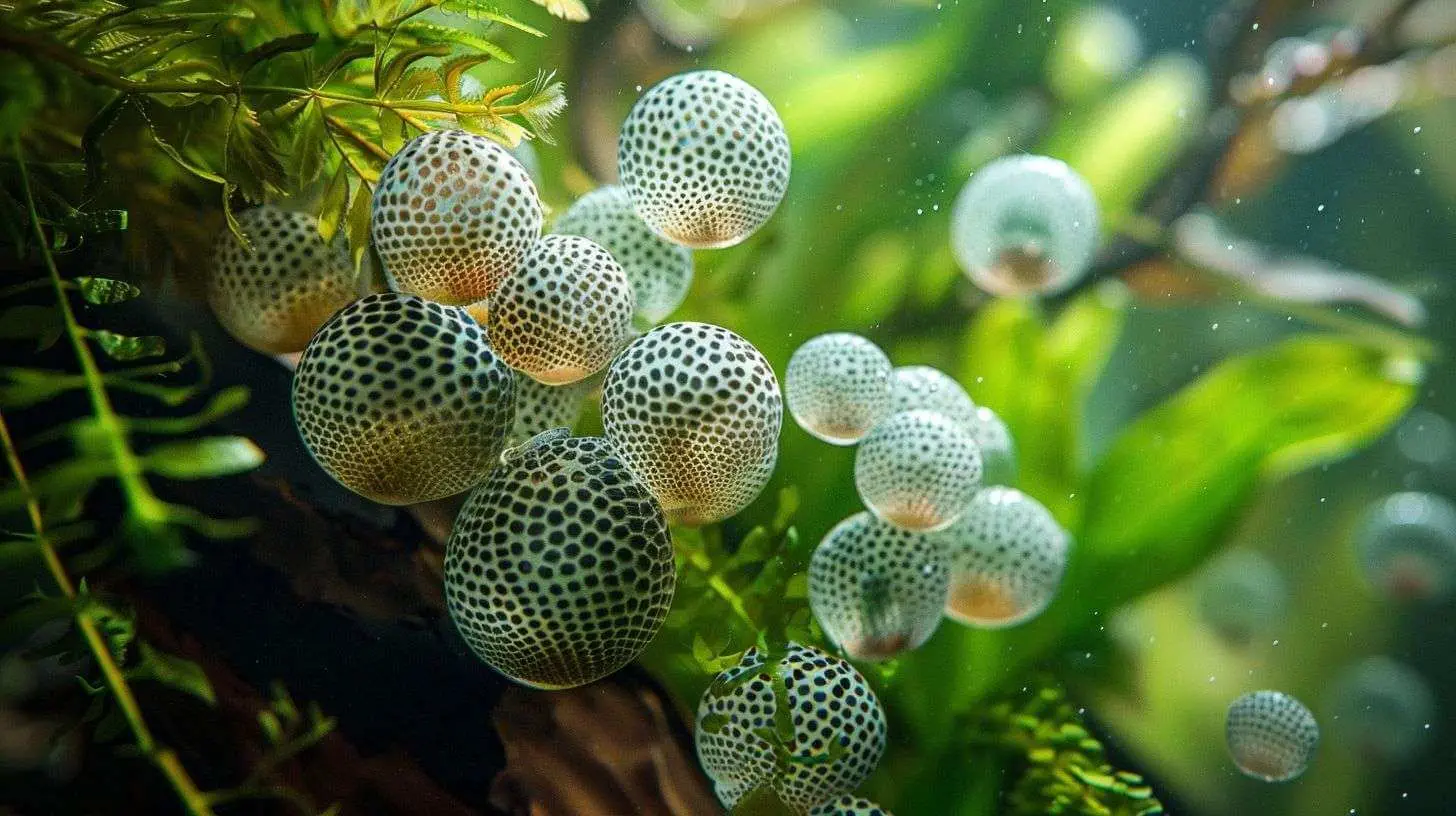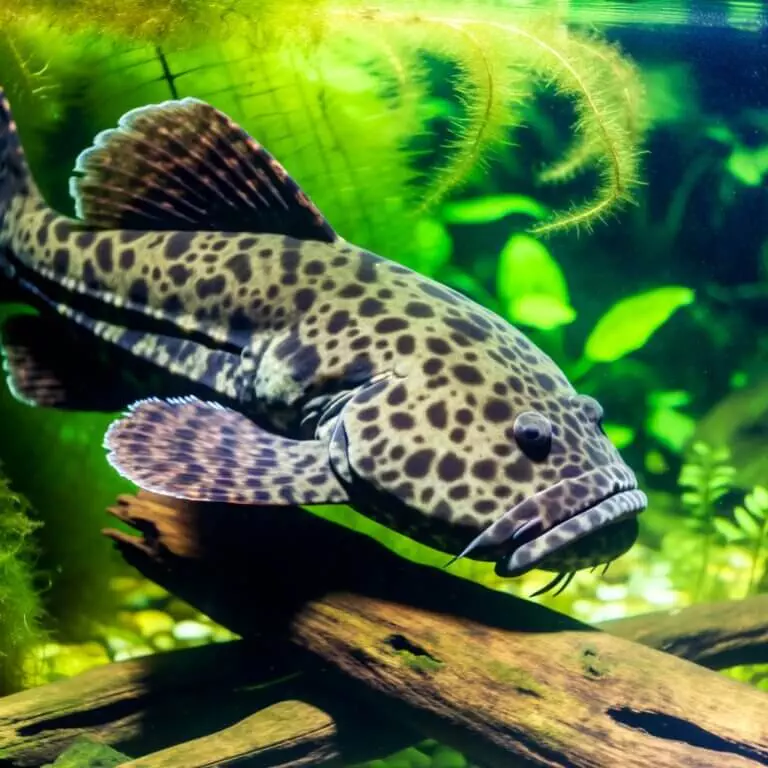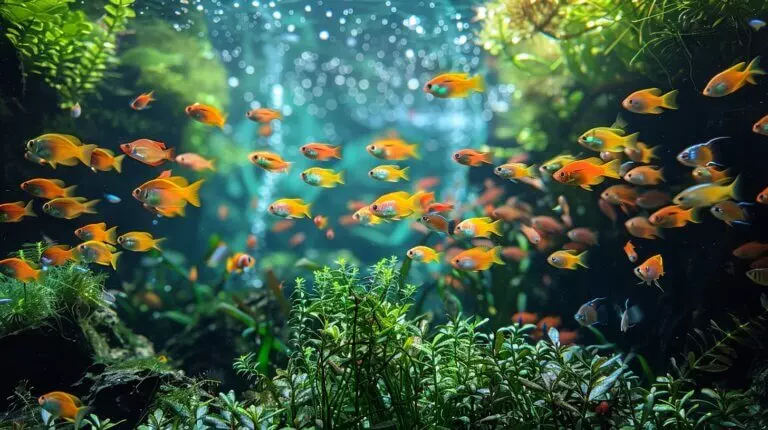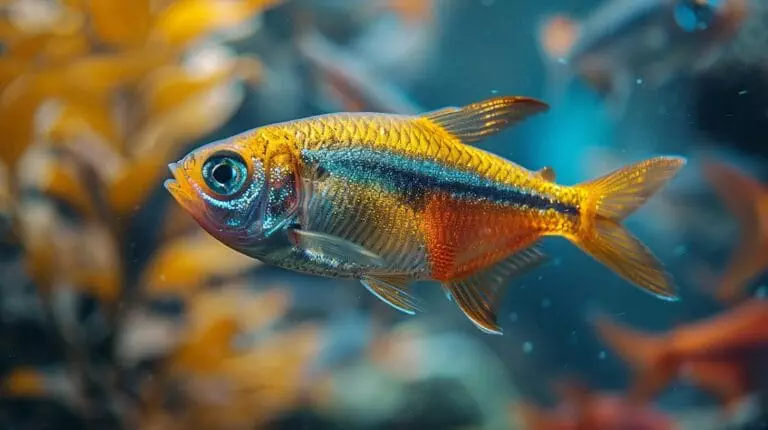Discovering mystery snail eggs in your aquarium can be an exciting experience, but it can also leave you with many questions about how to care for these delicate clutches. As a passionate aquarist and underwater photographer, I’ve encountered my fair share of mystery snail eggs and have learned the best practices for ensuring their healthy development.
In this comprehensive guide, we’ll explore everything you need to know about mystery snail eggs, from understanding the hatching process to creating the ideal environment for your newly hatched snails. Whether you’re a seasoned aquarium hobbyist or a curious beginner, this article will provide you with the knowledge and tools to successfully care for these fascinating creatures. Additionally, we will cover the importance of identifying snail shell colors as a way to monitor the health and well-being of your mystery snails. Understanding the various color variations can also help you differentiate between different species and determine the best care practices for each. By the end of this guide, you’ll be equipped with the expertise to confidently care for mystery snail eggs and their hatched offspring.
So, let’s dive into the world of mystery snail eggs and discover how to help them thrive in your aquatic ecosystem.
Key Takeaways
- Mystery snail eggs are laid in clutches of 50-200 eggs above the waterline and take 10 days to 4 weeks to hatch, depending on factors such as temperature (75-80°F or 24-27°C), humidity, and water quality.
- To create the ideal hatching environment, use a container with a tight-fitting lid, place the clutch on a damp paper towel or sponge, and maintain high humidity levels using clean, dechlorinated water. Provide gentle aeration and avoid drastic changes in conditions during incubation.
- Newly hatched mystery snails should be kept in a separate tank or breeder box with a sponge filter, fed a diet of soft, nutrient-rich foods like algae wafers and blanched vegetables, and gradually acclimated to the main aquarium once they reach the size of a pea (usually after 4-6 weeks).
- To breed mystery snails responsibly, ensure you have at least one male and one female, provide a suitable egg-laying surface above the waterline, carefully remove egg clutches using a razor blade or sharp object, and place them in a separate container with high humidity until they hatch.
- Common issues with mystery snail eggs include infertility due to a lack of males or underwater egg-laying, mold growth caused by high humidity or poor ventilation, and failure to hatch due to incorrect incubation conditions. Monitor the eggs daily and maintain stable temperature (65-82°F or 18-28°C) and humidity levels (70-80%) for successful hatching.
Understanding Mystery Snail Eggs and the Hatching Process
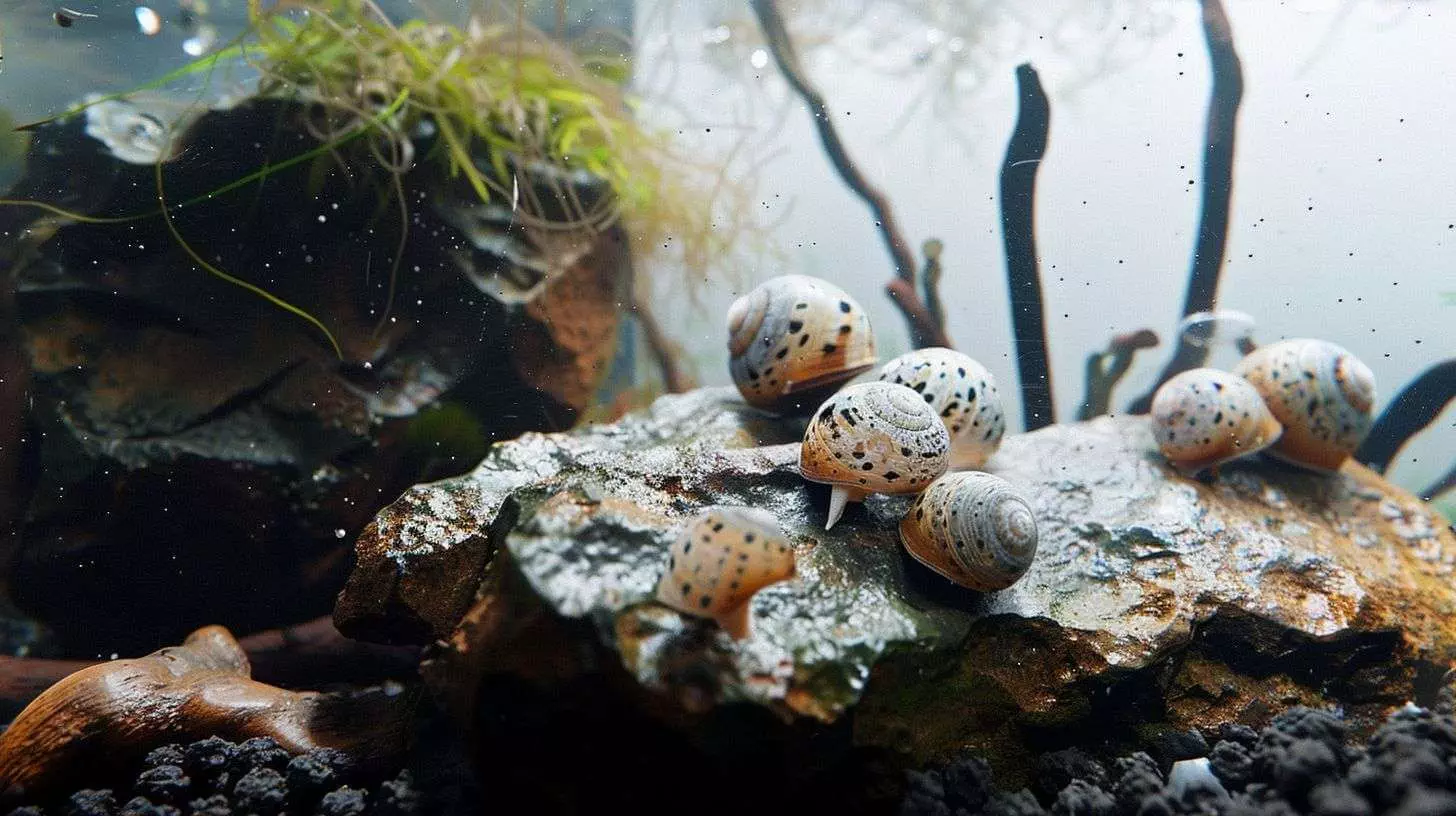
Mystery snail eggs are laid in gelatinous, round clusters against the upper lip of the aquarium, above the waterline. These clutches, resembling small, pink grapes, can contain anywhere from 50 to 200 eggs.
After the female mystery snail deposits her clutch, the eggs will start to develop and harden over the next few days. Keep an eye out for any signs of mold or fungus on the clutch, which can indicate infertility or poor water quality.
The hatching process for mystery snail eggs can take anywhere from 10 days to 4 weeks, depending on factors such as temperature, humidity, and the overall health of the eggs. In my experience, I’ve had clutches laid simultaneously hatch at different times – the first clutch hatched at 10 days, while the second took 14 days.
During this incubation period, the eggs will gradually change color, shifting from pink to a darker hue, and eventually becoming more translucent as the baby snails develop inside.
Once ready to hatch, the tiny snails will break through the egg casing and make their way into the water, where they’ll begin their journey as independent, miniature versions of their parents.
Creating the ideal environment is crucial for the successful hatching of your mystery snail clutches. The ideal environment for mystery snail clutches is one that mimics their natural habitat, with warm water, a stable pH level, and plenty of vegetation for the adult snails to lay their eggs on. Additionally, providing a secure and secluded area for the eggs to develop away from potential predators is essential. Handling mata mata turtle bites, which can occur if they mistake your finger for food, requires caution and gentle handling to avoid injury to both yourself and the turtle. It is important to educate yourself on the best practices for handling these bites to ensure the safety and well-being of your turtle.
Creating the Ideal Environment to Hatch Mystery Snail Eggs
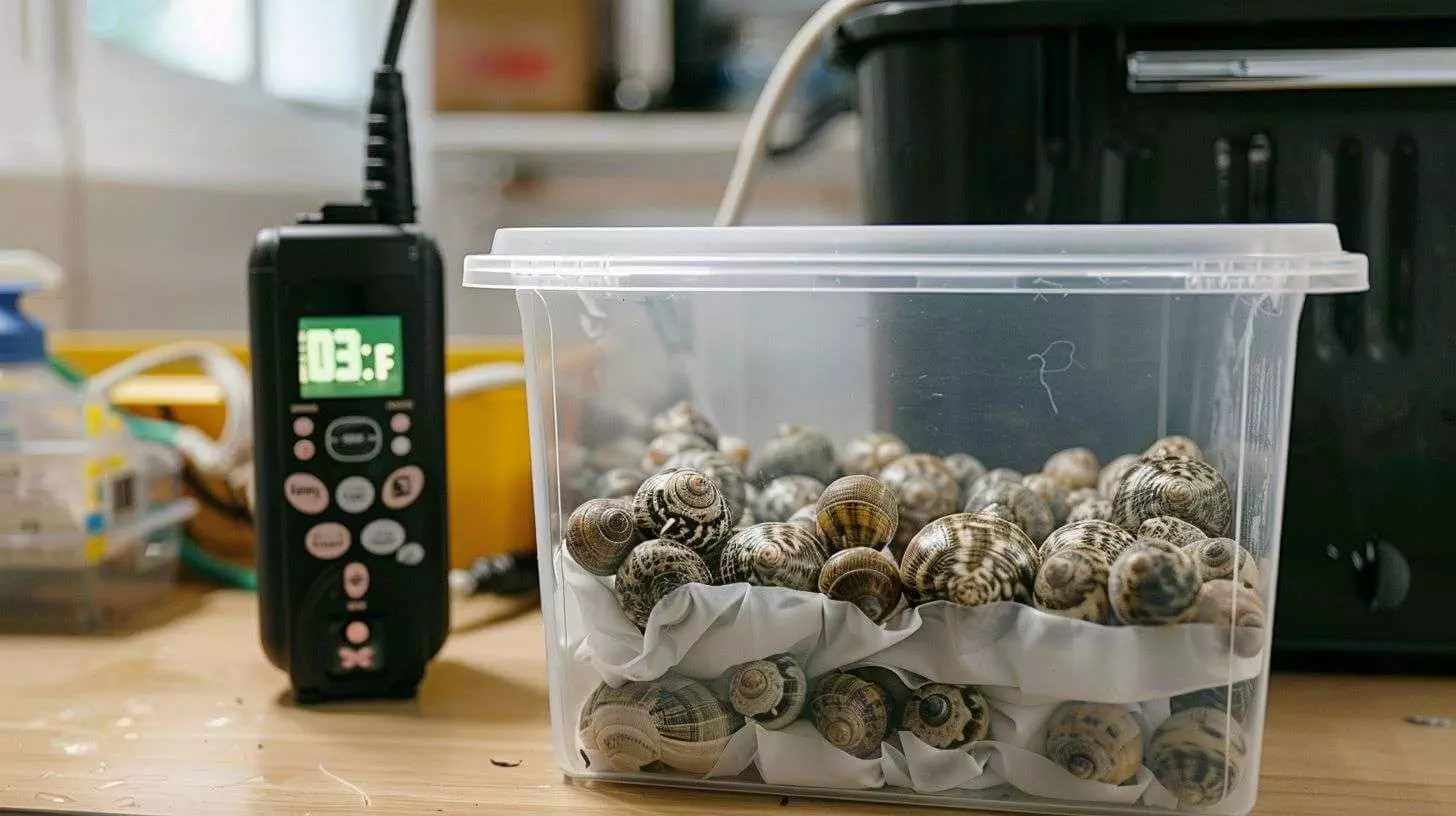
To successfully hatch Mystery Snail eggs, you must create the ideal environment that mimics their natural habitat. Here are the key factors to consider when setting up the perfect hatching environment:
- Water temperature: Maintain a consistent water temperature between 75-80°F (24-27°C) using a reliable aquarium heater. This temperature range is crucial for optimal egg development and hatching success.
- Humidity: Keep the eggs in a humid environment by placing them in a container with a tight-fitting lid. You can use a plastic container, Tupperware, or a breeder box to maintain high humidity levels around the eggs.
- Moisture: Ensure the eggs remain moist but not submerged in water. Place the clutch on a damp paper towel or sponge to provide the necessary moisture without drowning the eggs.
- Water quality: Use clean, dechlorinated water to maintain the humidity in the hatching container. Avoid using tap water, as it may contain harmful chemicals that can damage the eggs.
- Aeration: Provide gentle aeration near the hatching container to maintain proper oxygen levels. You can use a small air pump with an air stone or a sponge filter to create a slight current and improve water circulation.
- Lighting: Mystery Snail eggs do not require special lighting conditions. However, maintaining a regular day/night cycle can help promote healthy development.
- Predator-free environment: Keep the hatching container away from potential predators like fish or other aquatic invertebrates that may consume the eggs or newly hatched snails.
- Stable conditions: Avoid drastic changes in temperature, humidity, or water parameters during the incubation period. Consistency is key to ensuring successful hatching.
- Monitoring: Check the eggs daily for any signs of mold or fungal growth. If you notice any contamination, gently wipe the affected area with a clean, damp paper towel.
- Patience: Mystery Snail eggs typically take between 2 to 4 weeks to hatch, depending on the environmental conditions. Allow the eggs to develop at their own pace and resist the temptation to interfere with the process.
Care Guide for Newly Hatched Mystery Snails
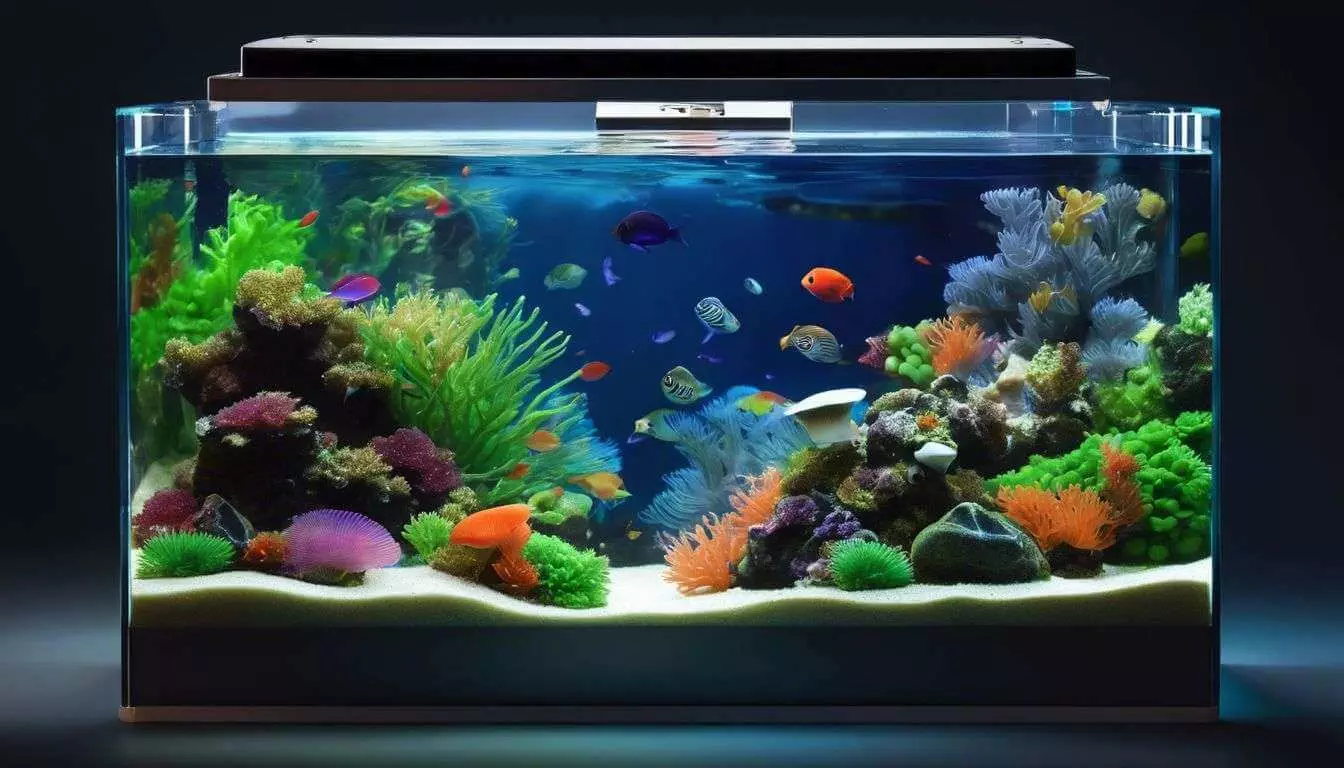
Newly hatched Mystery Snails require special care to ensure their survival and healthy growth. Provide them with a suitable environment, proper nutrition, and compatible tank mates to help them thrive.
- Set up a separate breeding tank or breeder box for the baby snails, with a sponge filter and gentle water flow to prevent them from being sucked into the filter.
- Maintain water parameters similar to the main aquarium, with a temperature between 68-82°F (20-28°C), pH between 7.0-8.0, and hardness between 6-18 dGH.
- Feed the baby snails a diet of soft, nutrient-rich foods such as algae wafers, blanched vegetables (spinach, zucchini, or lettuce), and sinking fish food pellets.
- Crush or finely chop the food to make it easier for the tiny snails to consume, and remove any uneaten food after a few hours to prevent water quality issues.
- Perform regular water changes (10-20% weekly) to maintain good water quality and remove any accumulated waste or uneaten food.
- Provide plenty of hiding spots and surfaces for the baby snails to graze on, such as aquarium plants, driftwood, or small rocks.
- Keep the baby snails in the separate tank or breeder box until they grow to about the size of a pea, which usually takes 4-6 weeks.
- Once the young Mystery Snails are large enough, you can gradually acclimate them to the main aquarium by placing them in a small container with water from the main tank and slowly adding more water over the course of an hour.
- Introduce the baby snails to the main aquarium during a low-stress period, such as after a water change or when the lights are off, to minimize the risk of predation by fish or other invertebrates.
- Monitor the young Mystery Snails closely for the first few days to ensure they are adapting well to their new environment and are not being harassed or eaten by tank mates.
How to Breed Mystery Snails and Harvest Eggs Responsibly
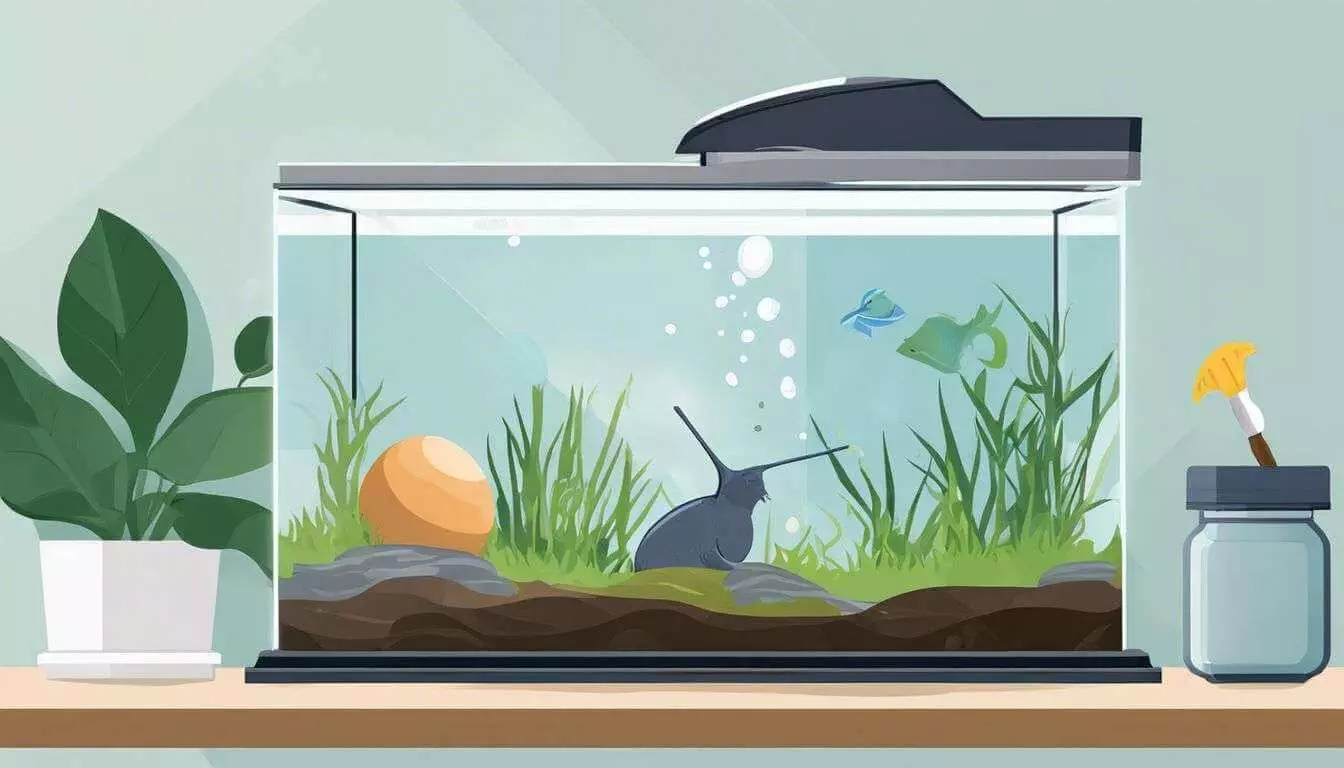
Breeding Mystery Snails can be a rewarding experience for aquarium hobbyists. To ensure responsible breeding and egg harvesting, follow these guidelines:
- Ensure you have at least one male and one female Mystery Snail in your aquarium. If unsure about their sex, purchase a group of six or more snails to increase the likelihood of having both genders, which can answer the question of how many eggs do mystery snails lay.
- Condition your snails for breeding by increasing their food intake and dropping the water line by 3-4 inches. This encourages them to lay eggs above the waterline.
- Provide a suitable surface for egg-laying, such as the aquarium hood or a piece of driftwood that extends above the water. Mystery Snails prefer to lay their eggs on smooth, hard surfaces.
- Monitor your snails closely for signs of egg-laying. Younger females typically lay between 50-100 eggs, while mature females can lay hundreds in a single clutch.
- Once you spot an egg clutch, carefully remove it from the aquarium using a razor blade or a sharp object. Be cautious not to damage the eggs or the surface they’re attached to.
- Place the egg clutch in a separate container with high humidity, such as a plastic box with a lid. Ensure the container has air holes to prevent mold growth.
- Mist the eggs daily with dechlorinated water to maintain moisture levels. The eggs should hatch within 1-4 weeks, depending on the temperature and humidity.
- When the baby snails hatch, gently transfer them to a separate grow-out tank with plenty of food and hiding spots. Avoid keeping them with adult snails, as they may become prey.
- As the baby snails grow, gradually introduce them to your main aquarium. Ensure they have plenty of food and calcium sources to support their shell development.
- To avoid overpopulation, consider selling or donating excess snails to local pet stores, aquarium clubs, or fellow hobbyists. Never release them into the wild, as they can disrupt natural ecosystems.
Troubleshooting Common Issues with Mystery Snail Eggs
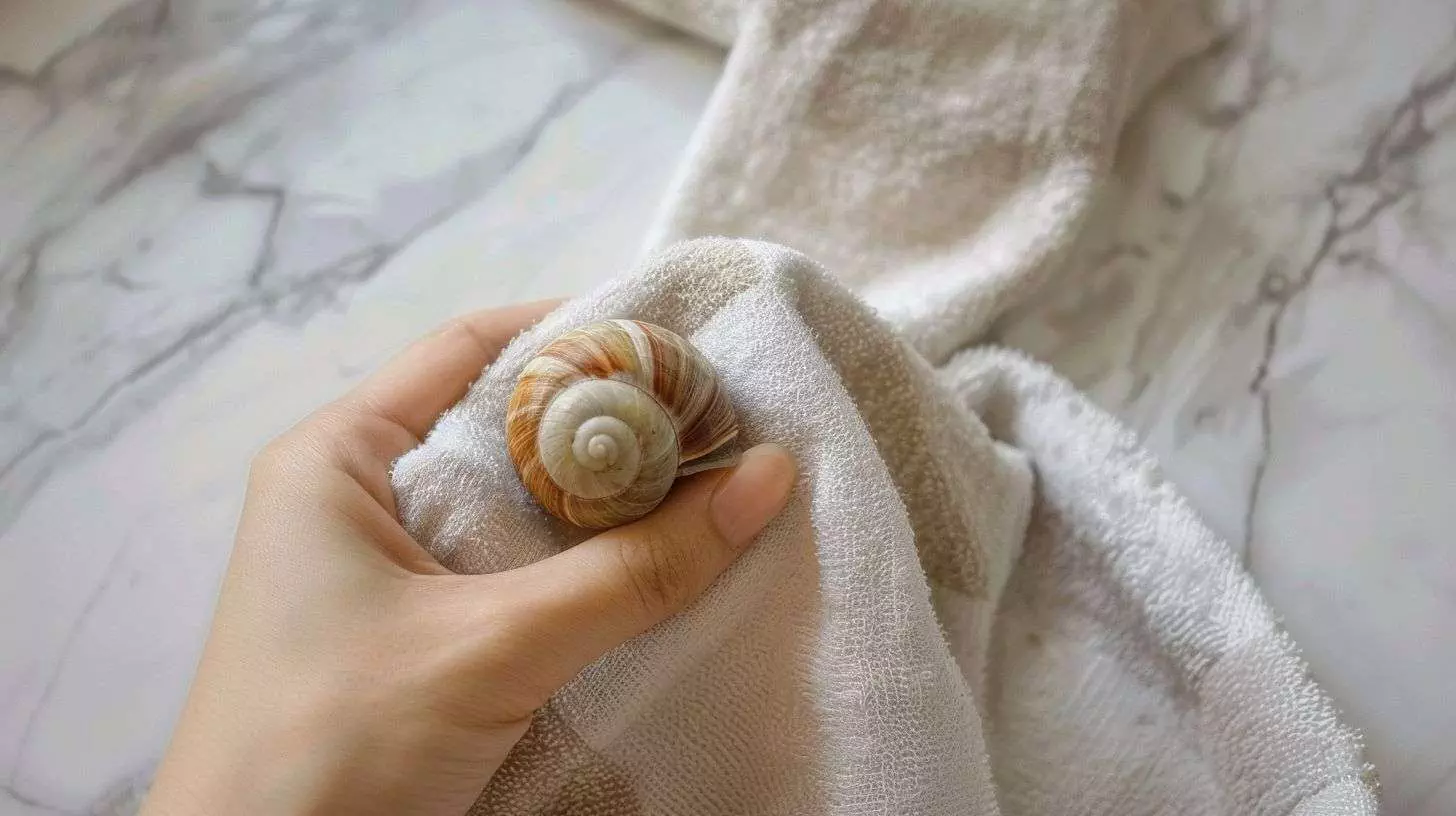
Common issues can arise when caring for mystery snail eggs, but don’t worry – there are solutions. Infertile eggs are a frequent problem, often due to a lack of males in the tank or eggs being laid underwater.
To prevent this, maintain a balanced ratio of male to female snails and ensure the clutch is deposited above the waterline. Mold is another obstacle, typically caused by high humidity or poor ventilation.
Combat mold by gently wiping the clutch with a soft, damp cloth and improving air circulation around the eggs.
.
In my experience, eggs failing to hatch is usually a result of incorrect incubation conditions. Maintain a stable temperature between 65-82°F (18-28°C) using an aquarium heater, and keep the humidity around 70-80% by misting the clutch regularly with dechlorinated water.
If the clutch dries out or falls into the tank, carefully remove it and place it in a separate container lined with damp paper towels. Monitor the eggs daily for signs of development, and be patient – hatching can take anywhere from 2 to 5 weeks, depending on the environmental conditions.
.
Can Snails and Frogs Live Together in the Same Habitat?
Yes, snails and frogs can live together in the same habitat. However, it’s important to create a suitable environment for both species. The mystery of burrowing frog behavior is just one aspect to consider when establishing a symbiotic relationship between snails and frogs in their shared habitat.
Conclusion

Caring for mystery snail eggs can be a rewarding experience for any aquarium enthusiast. By providing the right environment and following the guidelines outlined in this article, you can successfully hatch and raise healthy baby snails.
Share this knowledge with fellow hobbyists and enjoy the fascinating journey of breeding these captivating creatures. With dedication and proper care, your aquarium will soon be teeming with thriving mystery snails – a testament to your skills as an aquarist.
FAQs
1. What do mystery snail eggs look like?
Mystery snail eggs are laid in clutches above the water surface. They’re usually light pink or magenta in color and about 2 inches in size. The eggs resemble tiny grapes or worms clumped together.
2. How can you tell if mystery snail eggs are fertile?
Fertile mystery snail eggs are usually a bright pink or magenta color. Infertile eggs tend to be more white or translucent. You can also check for tiny dark spots inside each egg, which are the developing snail embryos.
3. How long does it take for mystery snail eggs to hatch?
Mystery snail eggs typically take 2-3 weeks to hatch, depending on the temperature and humidity. Keep the clutch moist but not wet, and avoid letting it fall into the aquarium water.
4. How many babies do mystery snails have?
A single clutch of mystery snail eggs can contain anywhere from 50 to 200 baby snails. How many eggs do mystery snails lay is often asked, and this provides the answer. Mystery snails can lay multiple clutches over their lifetime, potentially resulting in hundreds of offspring.
5. What do you do with mystery snail eggs in your aquarium?
If you find a clutch of mystery snail eggs in your aquarium, you can either leave it in place or carefully remove it. If leaving it, make sure it’s above the water line. If removing, place the clutch in a separate container with high humidity and slight ventilation.
6. How do you care for newly hatched mystery snails?
Once the eggs hatch, the baby snails will drop into the water. Provide them with a fine substrate, plenty of hiding spots, and small foods like algae wafers or blanched vegetables. Keep the water clean and maintain stable parameters suitable for mystery snails.
References
- https://www.theshrimpfarm.com/posts/breeding-mystery-snails/ (2024-03-18)
- https://forum.aquariumcoop.com/topic/26357-mystery-snail-eggs/ (2022-08-25)
- https://www.hepper.com/mystery-snail-eggs/
- https://www.aquariumcoop.com/blogs/aquarium/mystery-snail
- https://forum.aquariumcoop.com/topic/12371-breeding-mystery-snails/
- https://www.plantedtank.net/threads/mystery-snail-eggs.125996/ (2011-01-21)
- https://www.fishlore.com/aquariumfishforum/threads/help-with-mystery-snail-egg-clutch.272456/ (2017-03-25)

